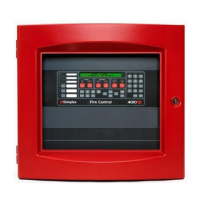2-2
Acknowledging an Alarm
How the 4010ES
Indicates that an
Alarm has
Occurred
When an alarm condition is detected by the 4010ES, the panel does the following to indicate the
presence of the alarm.
• Red LED, labeled Fire Alarm flashes.
• Tone-alert (piezo buzzer) pulses.
• LEDs on remote annunciators may illuminate.
• The alphanumeric display on the interface panel indicates an alarm condition. The exact manner
in which the alphanumeric display reports information for the alarm condition depends on
whether the system’s Display First Alarm Option is enabled.
- If Display 1st Alarm Option is Enabled. The display alternates between two screens
similar to Screen 1 and Screen 2 shown below. Screen 1 is a tally screen indicating the total
number of fire alarms, priority 2 alarms, supervisory conditions, and trouble conditions pres-
ent on the panel. Screen 2 is a detailed description of the first alarm received by the panel.
- If Display 1st Alarm Option is not enabled. Only a screen similar to Screen 1 appears,
indicating the total number of alarm conditions present on the system.
Overview -
Acknowledging
Alarms
The first step in managing an alarm condition is to acknowledge the alarm. Acknowledging an alarm
does two important things:
• It records the time and date at which you observed the presence of an alarm, trouble, or
supervisory condition on the operator interface panel and stores that information in the system’s
historical log.
• When you press the acknowledge key, the system displays specific data on the location of the
alarm.
It is important to understand that the 4010ES can be configured with either Global or Individual
Acknowledge. Global or Individual Acknowledge is selected in the System Options sub-tab of the
Panel Tab in the ES Panel Programmer. Global Acknowledge is the default. These options function as
follows:
• Global Acknowledge. When global acknowledge is enabled, one press of the FIRE ALARM
ACK (or the PRIORITY 2 ACK) key acknowledges every abnormal point currently reporting an
alarm status. This is helpful when a series of devices enter an alarm state (for example, all of the
smoke detectors in an area of the building) and you want to acknowledge all of them at the same
time.
• Individual Acknowledge. If individual acknowledge is enabled, the FIRE ALARM ACK (or
PRIORITY 2 ACK) key must be pressed to individually acknowledge each alarm. Individual
acknowledge must be selected if the panel is providing proprietary receiving service in
accordance with NFPA72.
The FIRE ALARM ACK (or the PRIORITY 2 ACK) key, which is used to acknowledge alarms
(either globally or individually), is located just beneath the ALARMS LEDs.

